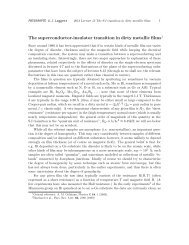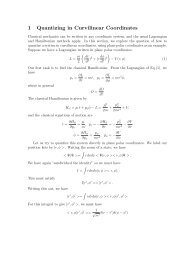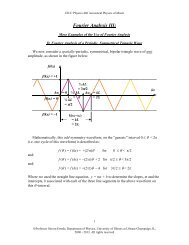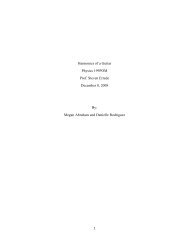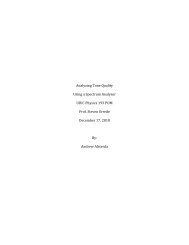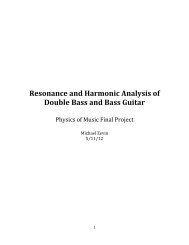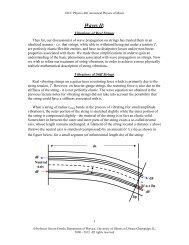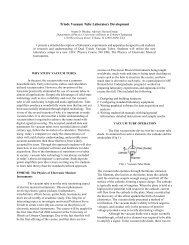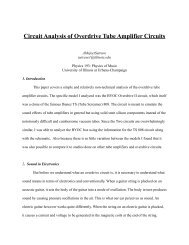Fender Stratocaster Analysis of Amplitude and Time Decay
Fender Stratocaster Analysis of Amplitude and Time Decay
Fender Stratocaster Analysis of Amplitude and Time Decay
Create successful ePaper yourself
Turn your PDF publications into a flip-book with our unique Google optimized e-Paper software.
<strong>Fender</strong> <strong>Stratocaster</strong> <strong>Analysis</strong> <strong>of</strong> <strong>Amplitude</strong> <strong>and</strong> <strong>Time</strong> <strong>Decay</strong><br />
1<br />
Josh Penas<br />
In this project, the amplitudes <strong>and</strong> time decay <strong>of</strong> the harmonics <strong>of</strong> guitar strings were measured.<br />
The open low E string <strong>and</strong> the G string were played with each <strong>of</strong> the 5 different pickups. Each time, the<br />
string was picked at about the middle pickup area but slightly toward the neck. After the sounds were<br />
recorded, the harmonics <strong>of</strong> each <strong>of</strong> the notes with the different pickups were analyzed using a computer<br />
program. The guitar was a <strong>Fender</strong> <strong>Stratocaster</strong> made in Mexico with a hum bucker pickup by the bridge.<br />
Both tone nobs were kept at the same level for each note.<br />
One <strong>of</strong> the main properties that was looked at was the amplitudes <strong>of</strong> each <strong>of</strong> the different<br />
harmonics for each played string. A 3D graph was looked at for each combination <strong>of</strong> string <strong>and</strong> pickup.<br />
This displayed the harmonic or mode on one axis, time on the one perpendicular to it, <strong>and</strong> the<br />
amplitude on the vertical axis. This showed how loud each <strong>of</strong> the frequencies were <strong>and</strong> for how long.<br />
What was consistently found was that the higher number harmonics <strong>of</strong> the notes played on the G string<br />
had higher amplitudes than higher modes <strong>of</strong> the notes <strong>of</strong> the E string no matter what the guitar pickup<br />
was at. This means that in general, the higher harmonics on the G string can be heard better than the<br />
higher harmonics on the E string. This makes sense when hearing the strings played. The notes on the E<br />
string have a deeper <strong>and</strong> s<strong>of</strong>t sound while the higher strings have a higher <strong>and</strong> sharper sound. They are<br />
lower not only because the string is thicker <strong>and</strong> the frequencies themselves are lower but the same note<br />
played on a higher string would sound different than played on a lower string. For example, when<br />
tuning the guitar, the notes are supposed to be the same but they still sound different because the<br />
strings themselves are different. On the following page are some comparisons <strong>of</strong> the 3D graphs <strong>of</strong> the E<br />
<strong>and</strong> G strings with the same pickups with E on the left <strong>and</strong> G on the right. The one right below is a<br />
comparison <strong>of</strong> the strings played with the neck pickups.
Neck PU Comparison: Open low E vs. Open G<br />
Neck‐Mid PU Comparison: Open low E vs. Open G<br />
The differences between the amplitudes <strong>of</strong> the different harmonics for the different pickups<br />
were also looked at. These differences were not as noticeable but the higher harmonics <strong>of</strong> the notes<br />
played with the neck‐mid pickups <strong>and</strong> the mid‐bridge pickups had lower amplitudes the higher<br />
harmonics <strong>of</strong> the other three. This is because the second <strong>and</strong> fourth pickups have a deeper <strong>and</strong> s<strong>of</strong>t<br />
tone while the other ones have a sharper tone. The bridge pickup has the sharpest tone <strong>and</strong> the higher<br />
modes <strong>of</strong> the notes played using bridge pickups were louder than any <strong>of</strong> the other pickups. The tone is<br />
sharp because many <strong>of</strong> the higher harmonics can be heard. Below are the 3D graphs <strong>of</strong> the low E string<br />
at the third, fourth, <strong>and</strong> firth pickups up to harmonics with frequencies <strong>of</strong> 1000Hz.<br />
2
The mid, fourth (or mid‐bridge), <strong>and</strong> bridge pickups<br />
are shown to the right with the mid on the top <strong>and</strong><br />
the bridge on the bottom. It is hard to tell much <strong>of</strong> a<br />
difference <strong>and</strong> the graphs look very similar to each<br />
other, but if you look closely, you can see that the<br />
amplitudes <strong>of</strong> the higher frequencies <strong>of</strong> the fourth<br />
pickup seem a little bit higher. This also makes sense<br />
since the sound <strong>of</strong> the middle pick up is sharper than<br />
the second <strong>and</strong> fourth not that sharp <strong>and</strong> is still<br />
somewhat s<strong>of</strong>t at the same time. The higher<br />
harmonics on the E string played with the bridge<br />
pickup have visibly higher amplitudes though. This<br />
also makes sense since the bridge pickup has the<br />
sharpest tone <strong>and</strong> would be the easiest to<br />
distinguish out <strong>of</strong> the three.<br />
All these results seem to show that higher pitched/<br />
sharper sounds are richer in the higher harmonics.<br />
To make a sound sharp sounding, add higher<br />
harmonics; <strong>and</strong> to make a deeper <strong>and</strong> s<strong>of</strong>t sound,<br />
add less <strong>of</strong> the higher harmonics. The amplitudes<br />
<strong>of</strong> harmonics seem to influence the tone <strong>of</strong> the<br />
sound <strong>and</strong> the pickups are probably designed to<br />
cause this effect on the amplitude <strong>of</strong> the harmonics.<br />
3
Another property <strong>of</strong> the harmonics that was looked at was the time decay, how long each <strong>of</strong> the<br />
harmonics lasted. The harmonics not only have different amplitudes by also different durations for<br />
which they sound.<br />
Looking at graphs <strong>of</strong> the sounds as a whole, the pickups do not seem to impact the time the<br />
sound is heard that much but the string seems to be an important factor. The sound signals for the<br />
notes on the E string seem to last longer while the sounds on the G string seem to get much quieter<br />
more quickly. The notes on the E string also become quieter at a fairly fast rate but not as much as the<br />
G strings. The open E notes also seem to have a consistently higher signal. The graphs that measured<br />
this showed the signal on the vertical axis <strong>and</strong> time on the horizontal. Below are graphs <strong>of</strong> the signals <strong>of</strong><br />
the open E <strong>and</strong> G strings with the first, second, <strong>and</strong> fifth pickups.<br />
Open Low E<br />
Open G<br />
4
The time decays for each <strong>of</strong> the individual harmonics were also looked at. The signal <strong>of</strong> each <strong>of</strong><br />
the first sixteen harmonics for all <strong>of</strong> the notes were measured over a period <strong>of</strong> about 3 seconds <strong>and</strong> a<br />
least squares exponential fit was made for each note’s harmonics since sound vibration is supposed to<br />
decay exponentiallyThe decay time constant was calculated for each <strong>of</strong> the harmonics. The analysis <strong>of</strong><br />
each <strong>of</strong> the harmonics was also split into two parts. One was the signal from 0.1 to 0.4 seconds <strong>and</strong> the<br />
other was from 0.5 to 3 seconds. The reason that this was done is because the signals for all <strong>of</strong> the<br />
harmonics actually increase from 0.1 to 0.4 seconds due to the transient response <strong>of</strong> the pickup. The<br />
<strong>Fender</strong> <strong>Stratocaster</strong> that was used was not an easy guitar to analyze because there are many things<br />
about it that complicate the measurements – coupling <strong>of</strong> string vibrations due to the tremolo bridge.<br />
Below are some <strong>of</strong> the graphs <strong>of</strong> the individual harmonics decaying, with four at a time.<br />
5
The two graphs on the top are <strong>of</strong> the first four harmonics <strong>of</strong> one <strong>of</strong> the notes, the bottom left is a graph<br />
<strong>of</strong> the least squares line for one <strong>of</strong> the notes <strong>and</strong> the bottom right one is a graph <strong>of</strong> the least squares line<br />
for the next eight harmonics <strong>of</strong> the same note as on the graph next to it. Hopefully, the little increase at<br />
the beginning is noticeable, at least on the top graphs. It is also probably noticeable how the line<br />
representing the fourth harmonic on the second <strong>and</strong> third graphs is significantly lower <strong>and</strong> the lines on<br />
the fourth graph are much squigglier. This is because the higher harmonics were harder to measure.<br />
This was also the first time the program was used on a guitar <strong>and</strong> as mentioned before, the particular<br />
guitar caused many complications.<br />
Least squares exponential fits were calculated, a graph was made as mentioned earlier. This<br />
graph displayed the time constants <strong>of</strong> the different frequencies both during the first half <strong>of</strong> a second <strong>and</strong><br />
the rest <strong>of</strong> the three seconds. The time constants <strong>of</strong> the first half a second are blue <strong>and</strong> the time<br />
constants for the rest <strong>of</strong> the three seconds are pink. Since the first half second measured was<br />
somewhat irregular, the time constants <strong>of</strong> the harmonics for this time frame were not really looked at.<br />
Unfortunately, I was not able to find many patterns for the time decays <strong>of</strong> the pink points either. It did<br />
seem like generally, the lower harmonics took longer to decay which makes sense. It also seems like<br />
after a certain harmonic, the time constants stayed roughly the same, for some <strong>of</strong> the graphs. For<br />
others, the time constants are all over the place <strong>and</strong> sometimes they increase as the harmonics get<br />
higher. The time constants for the harmonics during the first half <strong>of</strong> a second are mostly toward the<br />
bottom <strong>of</strong> the graph but in <strong>of</strong> them, they seem to correspond with the pink time constant <strong>of</strong> the same<br />
harmonic <strong>and</strong> follow a similar pattern/relative position to the other points. Another thing that was<br />
consistent was that the second harmonic on the open E string was always higher than the first <strong>and</strong> the<br />
highest. This is probably due to the specific guitar being a <strong>Fender</strong> <strong>Stratocaster</strong> on not for all E string in<br />
general. Here are a few <strong>of</strong> the graphs were a pattern is somewhat present below. The graph on the<br />
left is <strong>of</strong> the open E with the neck pickup <strong>and</strong> the right one is E with the fourth pickup.<br />
6
Some other things that I noticed were the points for the low harmonics on the E string were<br />
missing for a lot <strong>of</strong> the pickups <strong>and</strong> this was not the case for G. This could mean that the harmonics on<br />
the E string, or at least the low ones, are harder to measure because <strong>of</strong> the way the string is made. I did<br />
not notice any significant patterns between the time decays for different pickups for both the E <strong>and</strong> the<br />
G string when looking at both the graphs <strong>and</strong> the data. The time constants seem to be longer on the<br />
second <strong>and</strong> fourth pickups as a whole from looking at the numbers <strong>and</strong> glancing at the first two digits <strong>of</strong><br />
each number in each column but only for the G string <strong>and</strong> not by much, <strong>and</strong> the numbers for the G<br />
string <strong>and</strong> the fourth pickup did not make much sense at all. When looking at the numbers, I could also<br />
see the pattern <strong>of</strong> the first few harmonics being significantly higher while the rest being about at the<br />
same level. The time constants for the bridge pickups seemed shorter overall than the rest <strong>of</strong> the<br />
pickups which is what I expected. I did not notice many differences between the harmonics individually<br />
(if the harmonics were higher, then they were higher as a whole, the pattern <strong>of</strong> them decreasing did not<br />
seem to change, when it did follow the decreasing pattern). It seemed like the harmonics for the E<br />
string lasted longer than the harmonics on the G string but that was seen on the graphs <strong>of</strong> the signal as a<br />
whole shown earlier.<br />
7
The results from the time decay analysis seem to show that if anything that harmonics ring<br />
longer than the higher ones. This means that the note would become gradually less rich in harmonics as<br />
time progressed if it was true. Harmonics on the low E string also seem to ring longer than the G string<br />
as a whole <strong>and</strong> this seems certain. Also, among the first sixteen harmonics, there seems to be a point<br />
where the time constant does not decrease much or at all after a certain point, <strong>and</strong> that the lower<br />
harmonics last significantly longer than the higher ones. This may not be true but if it was, it would<br />
mean that the notes are not very rich in harmonics after a certain point in time once all the higher<br />
harmonics stop ringing. The pickups did not seem to affect how long the harmonics lasted that much<br />
but if they did, then the harmonics would probably last the longest on the second <strong>and</strong> fourth pickups<br />
<strong>and</strong> the shortest on the fifth or bridge pickup. This would make sense since the firth pickup has the<br />
sharpest sound <strong>and</strong> the second <strong>and</strong> fourth ones have s<strong>of</strong>ter sounds. The fifth pickup is also located near<br />
the bridge so the string is not vibrating as much. As mentioned earlier, the program was used on a<br />
guitar for the first time, <strong>and</strong> this guitar was not a very good example for the first time so much <strong>of</strong> the<br />
data is hard to makes sense <strong>of</strong> but there are some things that seem to be consistent <strong>and</strong> many<br />
possibilities.<br />
Overall, the pickups seem to have a bigger impact on the amplitudes <strong>of</strong> the harmonics than the<br />
time the last for. The different tones is most likely due more to the fact that more <strong>of</strong> the higher<br />
harmonics can be heard on some than others, though the time each <strong>of</strong> the harmonics last for may be a<br />
contributing factor. This would mean that the louder amplitudes do not last any longer than the quiet<br />
ones. However, the amplitudes <strong>of</strong> harmonics on guitar strings has been measured before so the method<br />
<strong>and</strong> program or doing it was much more developed <strong>and</strong> the time decay had never been measured<br />
before. Maybe later, <strong>and</strong> when a simpler guitar is being measured, more conclusions will be made, but<br />
there are still some findings, which shows that it will definitely be possible to find more in the future. As<br />
for the different strings, there seems to be differences among the harmonics as well. As a whole, they<br />
8
seem to last longer on the low E string but the higher harmonics on the G string seem to be louder.<br />
Between playing many notes on the different strings while using different pickups <strong>and</strong> changing many<br />
other things on the guitar, there are many sounds that can be made, <strong>and</strong> much more that can be<br />
analyzed about them, <strong>and</strong> even more that can be found out in the future.<br />
9



